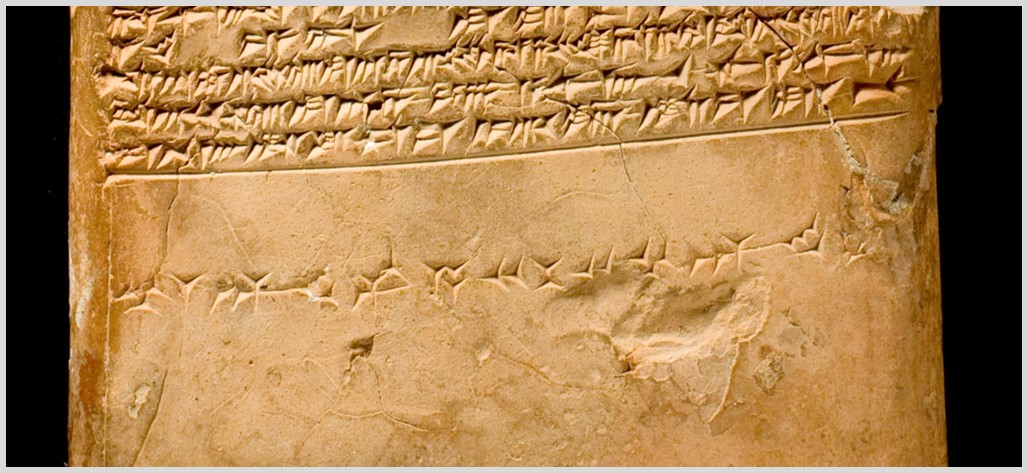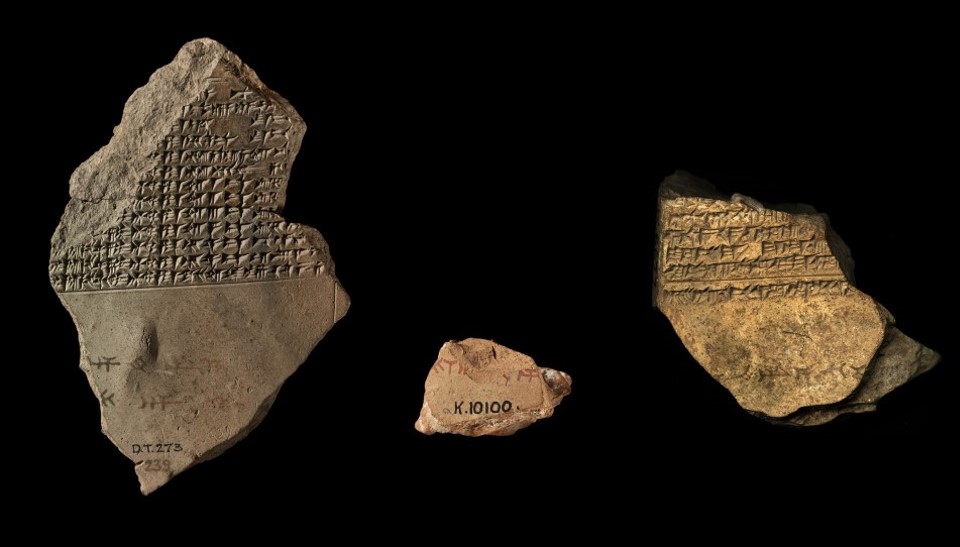The colophons explained
There are many Library colophons known today. Most are known by letters. These were allocated by Streck (1916). Others can be referenced using the numbers given in Hunger (1968), known as "BAK":
a b c d e g h i k BAK324 l m n o p q r/s t u v/BAK335 x y BAK336 BAK337 BAK338/339 BAK340 BAK341 BAK343 BAK344 BAK345 BAK346 BAK347 BAK348 BAK349
The following notes are the preliminary results of our research so far. We are currently developing a new typology that better represents the colophons.
The main library colophons
Asb a
Read the composite text [http://oracc.museum.upenn.edu/asbp/rlasb/Q009327/]
Colophon Asb a provides only the basic minimal titulature of Ashurbanipal as found in the colophons. It is typically written in a single line. The orthography of the text is noteworthy, setting it apart from the other colophons in several places. It is the most concise spelling possible. In five cases, Assyria is written as AŠki. There are no examples where it is written phonetically (aš-šurki, which is common elsewhere), neither is the first component of the king's name ever written phonetically; the last element of his name is always written A, whereas elsewhere DUMU.NITA2 is not uncommon.
The most characteristic feature of Asb a is that it almost always written on the tablet after the clay has dried. In three cases the colophon was made with ink rather than impressed. Given the poor survival of ink, and the competence with which these colophons are written, it seems likely that further tablets once bore inked colophons. This sets it apart from all other colophons, which are never written in this fashion. The phenomenon appears to be related to the brevity of the text; the clay was less well suited to inscription at the moment when this colophon was impressed. We might hypothesise that this colophon was viewed as the minimal ownership mark. It is really just a palace property label. Space issues are not the determining factor. While this colophon is found in some examples where there was little room available, there are plenty of examples where a large blank space is left.

An example of colophon Asb a added when the tablet was already dry. Detail of K 162 [https://www.britishmuseum.org/collection/object/W_K-162]. Copyright Trustees of the British Museum. CC BY-NC-SA 4.0 [https://www.britishmuseum.org/terms-use/copyright-and-permissions]

Colophon Asb a written in ink. Copyright Trustees of the British Museum. CC BY-NC-SA 4.0 [https://www.britishmuseum.org/terms-use/copyright-and-permissions]
A second characteristic feature of Asb a is its palaeography. The sign forms chosen are archaising, lapidary forms. They are not otherwise found in the colophons. This manifests most clearly in the KI sign. It is not clear why the minimal colophon, written after the tablet had dried, should employ this peculiar set of sign forms. The obvious question is why some tablets should have been in dry condition before entry into the Library. These tablets seem to have been written earlier, during the reign of one of Ashurbanipal's predecessors. It can't be ruled out that some had been written elsewhere, such as in Babylonia. It seems clear that these tablets had not originally been intended for the royal collection. The colophon marks transferal of ownership.
Asb b
Read the composite text [http://oracc.museum.upenn.edu/asbp/rlasb/Q009328/]
Colophon Asb b begins with an extended royal genealogy. It then adds a remarkable statement about the history of the tablets. These tablets are said to have been copied from originals from across Assyria and Babylonia, in the form of writing boards or tablets. In other words, rather than copying a single original, they collate multiple versions circulating within the empire. It concludes with the essentially the same protective formulae as Asb c. Most tablets with this colophon contain divinatory texts, although it is also attached to lexical texts and other inscriptions. This colophon seems to be the first library colophon composed during Ashurbanipal's reign.
Asb c
Read the composite text [http://oracc.museum.upenn.edu/asbp/rlasb/Q009329/]
ColophonAsb c is the standard, default colophon type applied to many types of text, but not extispicy. It is found in two variant forms, the significance of which is not yet clear. It is directly related to Asb d in particular, but also Asb q.
Asb d
Read the composite text [http://oracc.museum.upenn.edu/asbp/rlasb/Q009330/]
Colophon Asb d appears to be an abbreviated version of Asb c, used when space on the tablet is limited. Alternatively, Asb c could be an extended version of this colophon. As a version of the default colophon, it is also very common.
Asb q
Read the composite text [http://oracc.museum.upenn.edu/asbp/rlasb/Q009336/]
Colophon Asb q is a special type applied to tablets belonging to a medical compendium called the "Nineveh Medical Encyclopaedia" [http://oracc.org/asbp/NinMed/], as well as related medical texts. It derives from the default colophon Asb c/d, and must have been planned at the same time as them.
Asb l
Read the composite text [http://oracc.museum.upenn.edu/asbp/rlasb/Q009333/]
Colophon Asb l begins and ends the same as Asb d, but includes a different description of divine support and a content-specific clause. It is well attested, used for divinatory texts. There is a strong correlation between this colophon type and the presence of so-called "firing holes".
Uncommon library colophons
Several colophons are attested less often than the main types, but still in multiple manuscripts.
Asb g
Read the composite text [http://oracc.museum.upenn.edu/asbp/rlasb/Q009332/]
Asb g is dedicated to a plant list called Uruanna. It records extensive editorial work on earlier plant lists. This work is attributed to Ashurbanipal himself.
Asb e
Read the composite text [http://oracc.museum.upenn.edu/asbp/rlasb/Q009331/]
Colophon Asb e is a significant abbreviation of Asb c.
Asb k variant
Colophon Asb k variant is typically found on commentaries. It belongs to a group of closely related colophons, alongside Asb i, Asb k, BAK 324, BAK 336, BAK 337, and BAK 341.
Asb r/s
Read the composite text [http://oracc.museum.upenn.edu/asbp/rlasb/Q009337/]
Colophon Asb r/s is often found on manuscripts of the ritual text called Bit rimki.
Asb v
Read the composite text [http://oracc.museum.upenn.edu/asbp/rlasb/Q009338]
Colophon Asb v is found on texts in the Emesal dialect of Sumerian.
Asb x
Colophon Asb x is a previously undocumented colophon.
Isolated library colophons
These colophons are each attested only once or a few times.
Asb i
Read the composite text [http://oracc.museum.upenn.edu/asbp/rlasb/Q009342/]
This colophon belongs to a group of closely related colophons, alongside Asb k, Asb k var, BAK 324, BAK 336, BAK 337, and BAK 341.
Asb k
Read the composite text [http://oracc.museum.upenn.edu/asbp/rlasb/Q009349/]
This colophon belongs to a group of closely related colophons, alongside Asb i, Asb k var, BAK 324, BAK 336, BAK 337, and BAK 341.
Asb 324
Read the composite text [http://oracc.museum.upenn.edu/asbp/rlasb/Q009346/]
This colophon belongs to a group of closely related colophons, alongside Asb i, Asb k, Asb k var, BAK 336, BAK 337, and BAK 341.
Asb 336
Read the composite text [http://oracc.museum.upenn.edu/asbp/rlasb/Q009347/]
This colophon belongs to a group of closely related colophons, alongside Asb i, Asb k, Asb k var, BAK 324, BAK 337, and BAK 341.
Asb 337
Read the composite text [http://oracc.museum.upenn.edu/asbp/rlasb/Q009348/]
This colophon belongs to a group of closely related colophons, alongside Asb i, Asb k, Asb k var, BAK 324, BAK 336, and BAK 341.
Asb 341
Read the composite text [http://oracc.museum.upenn.edu/asbp/rlasb/Q009352/]
This colophon belongs to a group of closely related colophons, alongside Asb i, Asb k, Asb k var, BAK 324, BAK 336, and BAK 337.
Asb f
Read the composite text [http://oracc.museum.upenn.edu/asbp/rlasb/Q009340/]
This colophon is related to Asb c/d/e.
Asb m
Read the composite text [http://oracc.museum.upenn.edu/asbp/rlasb/Q009334/]
These tablets all contain the archaic literary text known as Lugale.
Asb h
Read the composite text [http://oracc.museum.upenn.edu/asbp/rlasb/Q009341/]
Only one tablet bears this colophon.
Asb p
This colophon is attested only once.
Asb t
Read the composite text [http://oracc.museum.upenn.edu/asbp/rlasb/Q009344/]
This colophon is attested only once.
Asb u
Read the composite text [http://oracc.museum.upenn.edu/asbp/rlasb/Q009345/]
This colophon is attested only once.
Asb y
Colophon Asb y is previously undocumented.
Asb 340
Read the composite text [http://oracc.museum.upenn.edu/asbp/rlasb/Q009351/]
This colophon is probably attested only once.
Asb 343
This colophon is attested only once.
Asb 344
This colophon is attested twice.
Asb 345
This colophon is attested only once.
Asb 346
This colophon is attested only once.
Asb 347
This colophon is attested only once.
Asb 348
This colophon is attested only once.
Asb 349
This colophon is attested only once.
Nabu temple library colophons
Asb o
Read the composite text [http://oracc.museum.upenn.edu/asbp/rlasb/Q009335/]
Colophon Asb o is substantially different. It also has a different purpose: this colophon marks tablets dedicated by Ashurbanipal to the temple library of Nabu, god of writing. It is found on texts belonging to the craft of the lamentation priest.
Asb n
Read the composite text [http://oracc.museum.upenn.edu/asbp/rlasb/Q009343/]
Colophon Asb n is found on various texts.
Asb 338/339
Read the composite text [http://oracc.museum.upenn.edu/asbp/rlasb/Q009339/]
Colophon Asb 338/339 is found on various texts.
There are also at least 4 previously undocumented Nabu temple colophons.
Further reading
- J. Taylor, E. Jiménez, B. Schnitzlein, S. Cohen, "The colophons of Ashurbanipal, King of the World", in S. Schmidtke and G.A. Kiraz (eds), Literary Snippets: Colophons Across Space and Time (forthcoming)
- B. Schnitzlein and S. Cohen, "News from Ashurbanipal's Library", in: S. de Martino, E. Devecchi, C. Lippolis, V. Messina and M. Viano (eds.), Proceedings of the 67th Rencontre Assyriologique Internationale (forthcoming)
- A.R. George, "Layard of Nineveh and the tablets of Nineveh", in S. Ermidoro, Stefania and C. Riva, (eds.), Rethinking Layard 1817-2017. Venice: Istituto Veneto di Scienze Lettere ed Arti (2020), pp. 3-24.
Jonathan Taylor
Jonathan Taylor, 'The colophons explained', Reading the Library of Ashurbanipal, Reading the Library of Ashurbanipal project, Department of the Middle East, The British Museum, Great Russell Street, London WC1B 3DG and Institut fuer Assyriologie und Hethitologie, Ludwig Maximilian University, Geschwister Scholl-Platz 1, 80539 Munich, 2022 [http://oracc.museum.upenn.edu/RLAsb/Librarycolophons/Colophonsexplained/]